传播学经典理论英文版
- 格式:docx
- 大小:27.97 KB
- 文档页数:11
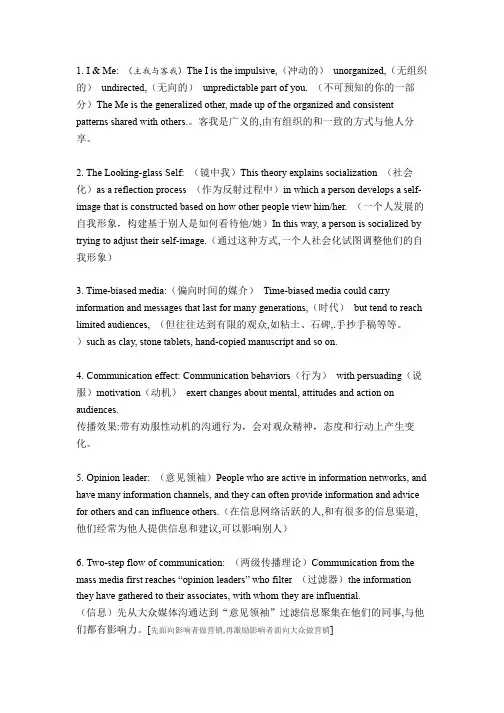
1. I & Me: (主我与客我)The I is the impulsive,(冲动的)unorganized,(无组织的)undirected,(无向的)unpredictable part of you. (不可预知的你的一部分)The Me is the generalized other, made up of the organized and consistent patterns shared with others.。
客我是广义的,由有组织的和一致的方式与他人分享。
2. The Looking-glass Self: (镜中我)This theory explains socialization (社会化)as a reflection process (作为反射过程中)in which a person develops a self-image that is constructed based on how other people view him/her. (一个人发展的自我形象,构建基于别人是如何看待他/她)In this way, a person is socialized by trying to adjust their self-image.(通过这种方式,一个人社会化试图调整他们的自我形象)3. Time-biased media:(偏向时间的媒介)Time-biased media could carry information and messages that last for many generations,(时代)but tend to reach limited audiences, (但往往达到有限的观众,如粘土、石碑,.手抄手稿等等。
)such as clay, stone tablets, hand-copied manuscript and so on.munication effect: Communication behaviors(行为)with persuading(说服)motivation(动机)exert changes about mental, attitudes and action on audiences. 传播效果:带有劝服性动机的沟通行为,会对观众精神,态度和行动上产生变化。
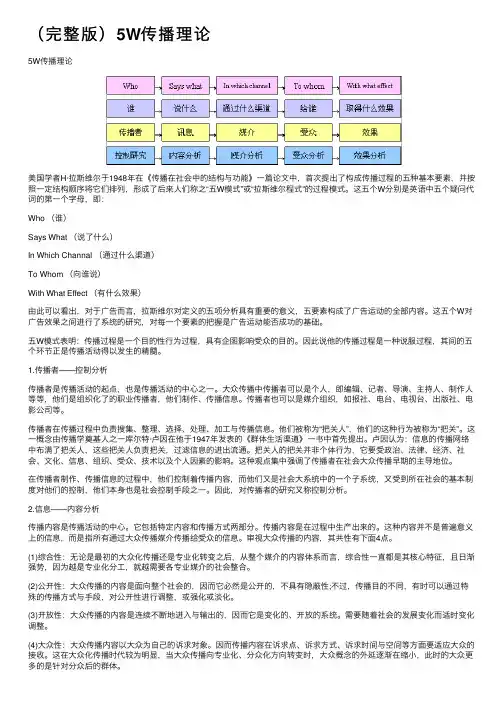
(完整版)5W传播理论5W传播理论美国学者H·拉斯维尔于1948年在《传播在社会中的结构与功能》⼀篇论⽂中,⾸次提出了构成传播过程的五种基本要素,并按照⼀定结构顺序将它们排列,形成了后来⼈们称之“五W模式”或“拉斯维尔程式”的过程模式。
这五个W分别是英语中五个疑问代词的第⼀个字母,即:Who (谁)Says What (说了什么)In Which Channal (通过什么渠道)To Whom (向谁说)With What Effect (有什么效果)由此可以看出,对于⼴告⽽⾔,拉斯维尔对定义的五项分析具有重要的意义,五要素构成了⼴告运动的全部内容。
这五个W对⼴告效果之间进⾏了系统的研究,对每⼀个要素的把握是⼴告运动能否成功的基础。
五W模式表明:传播过程是⼀个⽬的性⾏为过程,具有企图影响受众的⽬的。
因此说他的传播过程是⼀种说服过程,其间的五个环节正是传播活动得以发⽣的精髓。
1.传播者——控制分析传播者是传播活动的起点,也是传播活动的中⼼之⼀。
⼤众传播中传播者可以是个⼈,即编辑、记者、导演、主持⼈、制作⼈等等,他们是组织化了的职业传播者,他们制作、传播信息。
传播者也可以是媒介组织,如报社、电台、电视台、出版社、电影公司等。
传播者在传播过程中负责搜集、整理、选择、处理、加⼯与传播信息。
他们被称为“把关⼈”,他们的这种⾏为被称为“把关”。
这⼀概念由传播学奠基⼈之⼀库尔特·卢因在他于1947年发表的《群体⽣活渠道》⼀书中⾸先提出。
卢因认为:信息的传播⽹络中布满了把关⼈,这些把关⼈负责把关,过滤信息的进出流通。
把关⼈的把关并⾮个体⾏为,它要受政治、法律、经济、社会、⽂化、信息、组织、受众、技术以及个⼈因素的影响。
这种观点集中强调了传播者在社会⼤众传播早期的主导地位。
在传播者制作、传播信息的过程中,他们控制着传播内容,⽽他们⼜是社会⼤系统中的⼀个⼦系统,⼜受到所在社会的基本制度对他们的控制,他们本⾝也是社会控制⼿段之⼀。
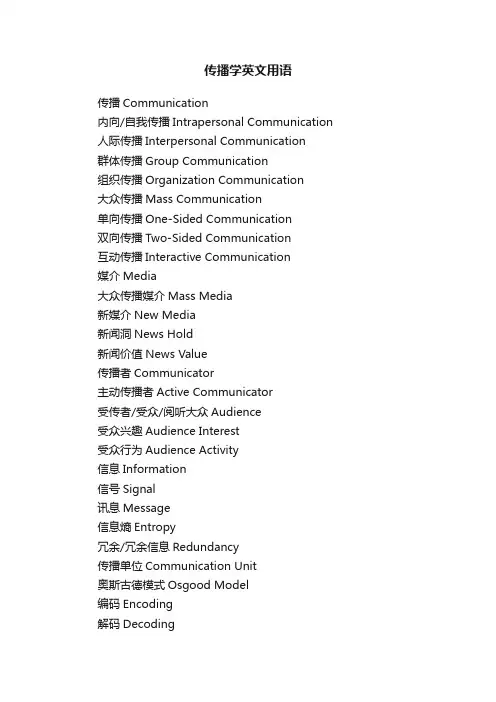
传播学英文用语传播Communication内向/自我传播Intrapersonal Communication 人际传播Interpersonal Communication群体传播Group Communication组织传播Organization Communication大众传播Mass Communication单向传播One-Sided Communication双向传播Two-Sided Communication互动传播Interactive Communication媒介Media大众传播媒介Mass Media新媒介New Media新闻洞News Hold新闻价值News Value传播者Communicator主动传播者Active Communicator受传者/受众/阅听大众Audience受众兴趣Audience Interest受众行为Audience Activity信息Information信号Signal讯息Message信息熵Entropy冗余/冗余信息Redundancy传播单位Communication Unit奥斯古德模式Osgood Model编码Encoding解码Decoding信源Source传播的数学理论Mathematical Theory of Communication 传播渠道Communication Channel有效传播Effective Communication传播效果Effects知识沟Knowledge-Gap使用与满足模式Uses and Gratifications Model使用与依从模式Uses and Dependencys Model口传系统System of Oral Communication地球村Global Village内爆Implosion全球化Globalization本土化Localization电子空间Cyber Space数字化Digitalization文化帝国主义Culture Imperialism守门人Gatekeeper新闻采集者News Gatherers新闻加工者News Processors模式Model有线效果模式Limited Effects Model适度效果模式Moderate Effects Model强大效果模式Powerful Effects Model子弹论Bullet Theory两级传播模式Two-Step Flow Model多级传播模式Multi-Step Flow Model沉默的螺旋模式Spiral of Silence Model劝服传播Persuasive Communication议程设置模式the Agenda-Setting Model时滞Time Lag最合适效果跨度Optimal Effects Pan时间跨度Time Span公众舆论Public Opinion选择性接触Selective Exposure选择性注意Selective Attention选择性理解Selective Perception选择性记忆Selective Retention可信性提示Credibility Heuristic喜爱提示Liking Heuristic共识提示Consensus Heuristic市场驱动新闻学the Market-Driven Journalism 意识形态Ideology霸权Hegemony权力话语Power Discourse视觉文本Visual Text文本Text超级文本Hypertext结构主义Constructionism解构主义Deconstructionism文化工业Culture Industry大众文化Mass Culture文化研究Cultural Studies批判学派/批判理论Critical Theory法兰克福学派Frankfurt School女权主义/女性主义Feminism符号学Semiotics/Semiology符号Sign能指与所指Signified/Signifier非语言符号Nonverbal Sign意指Signification话语理论Theories of Discourse文化期待Culture Expectations文化批判Culture Criticizing范式Paradigm叙事范式Narrative Paradigm强语境High Context弱语境Low Context功能理论Functionalism话语分析Discourse Analysis传播的商品形式the Commodity Forms of Communication 受众商品Audience Commodity商品化Commodification空间化Spatialization结构化Structuration媒介集中化Media Conglomeration传媒产业Media Industry注意力经济Attention Economy媒介竞争Media Competition受众分割Audience Segmentation媒介资本Media Capital传播政治经济学Political Economy of Communication传播研究Communication Research抽样Sampling调查研究方法Survey Research内容分析法Content Analysis实验分析法Experimental Research定性研究法Qualitative Research Methods个案研究法Case Study效度与信度Validity/Reliability变量Variables实地观察法Field Observation虚拟社群Virtual Community扩散研究Diffusion Research媒介事件Media Events民族志Ethnography传播生态Ecology of Communication真实/虚构Reality/Fiction拟态环境Pseudo-Environment刻板成见Stereotyping晕轮效应Halo Effects二元价值评判Two-Valued Evaluation公共关系Public Relation阐释理论Interpretive Theory第二部分:新闻采编相关词汇daily 日报morning edition 晨报evening edition 晚报quality paper 高级报纸popular paper 大众报纸evening paper 晚报government organ 官报part organ 党报trade paper 商界报纸vernacular paper 本国文报纸political news 政治报纸Newspaper Week 新闻周刊the front page 头版,第一版bulldog edition 晨版article 记事headline 标题banner headline 头号大标题byline 标题下署名之行dateline 日期、发稿地之行big news 头条新闻hot news 最新新闻exclusive news 独家新闻scoop 特讯feature 特写,花絮criticism 评论editorial 社论review, comment 时评book review 书评topicality 时事问题city news 社会新闻column 栏letters 读者投书栏general news column 一般消息栏cartoon, comics 漫画weather forecast 天气预报serial story 新闻小说obituary notice 讣闻public notice 公告advertisement 广告calssified ad 分类广告flash-news 大新闻extra 号外the sports page 运动栏literary criticism 文艺评论Sunday features 周日特刊newsbeat 记者采访地区news blackout 新闻管制press ban 禁止刊行yellow sheet 低俗新闻tabloid 图片版新闻"Braille" edition 点字版newspaper office 报社publisher 发行人proprieter 社长bureau chief, copy chief 总编辑editor-in-chief 总主笔editor 编辑, 主笔newsman, newspaperman, journalist 新闻记者cub reporter 初任记者reporter 采访记者war correspondent, campaign badge 随军记者columnist 专栏记者star reporter 一流通讯员correspondent 通讯员special correspondent 特派员contributor 投稿家news source 新闻来源informed sources 消息来源newspaper campaign 新闻战free-lancer writer 自由招待会press box 记者席news conference, press conference 记者招待会International Press Association 国际新闻协会distribution 发行circulation 发行份数newsstand, kiosk 报摊newspaper agency 报纸代售处newsboy 报童subscription (rate) 报费newsprint 新闻用纸Fleet Street 舰队街accredited journalist n. 特派记者advertisement n.广告advance n.预发消息;预写消息affair n.桃色新闻;绯闻anecdote n.趣闻轶事assignment n.采写任务attribution n. 消息出处,消息来源back alley news 小道消息backgrounding 新闻背景Bad news travels quickly. 坏事传千里。
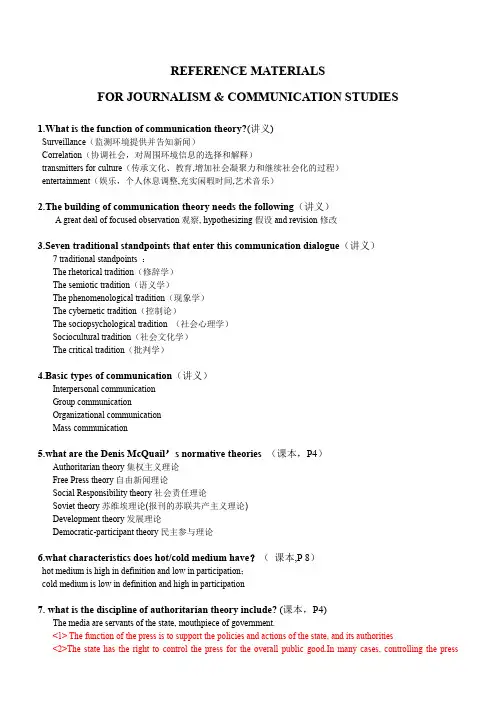
REFERENCE MATERIALSFOR JOURNALISM & COMMUNICATION STUDIES1.What is the function of communication theory?(讲义)Surveillance(监测环境提供并告知新闻)Correlation(协调社会,对周围环境信息的选择和解释)transmitters for culture(传承文化、教育,增加社会凝聚力和继续社会化的过程)entertainment(娱乐,个人休息调整,充实闲暇时间,艺术音乐)2.The building of communication theory needs the following(讲义)A great deal of focused observation观察, hypothesizing假设and revision修改3.Seven traditional standpoints that enter this communication dialogue(讲义)7 traditional standpoints :The rhetorical tradition(修辞学)The semiotic tradition(语义学)The phenomenological tradition(现象学)The cybernetic tradition(控制论)The sociopsychological tradition (社会心理学)Sociocultural tradition(社会文化学)The critical tradition(批判学)4.Basic types of communication(讲义)Interpersonal communicationGroup communicationOrganizational communicationMass communication5.what are the Denis McQuail’s normative theories (课本,P4)Authoritarian theory集权主义理论Free Press theory自由新闻理论Social Responsibility theory社会责任理论Soviet theory苏维埃理论(报刊的苏联共产主义理论)Development theory发展理论Democratic-participant theory民主参与理论6.what characteristics does hot/cold medium have?(课本,P 8)hot medium is high in definition and low in participation;cold medium is low in definition and high in participation7. what is the discipline of authoritarian theory include? (课本,P4)The media are servants of the state, mouthpiece of government.<1> The function of the press is to support the policies and actions of the state, and its authorities<2>The state has the right to control the press for the overall public good.In many cases, controlling the pressmeans preventing the press from embarrassing the existing government, to repress criticism and protest, and to severely restrict press freedom(参考PPT “communications control”)(如何展开:政府对媒体的角色是主导者,控制者,媒体相对于政府是被控制者,仆人,喉舌。
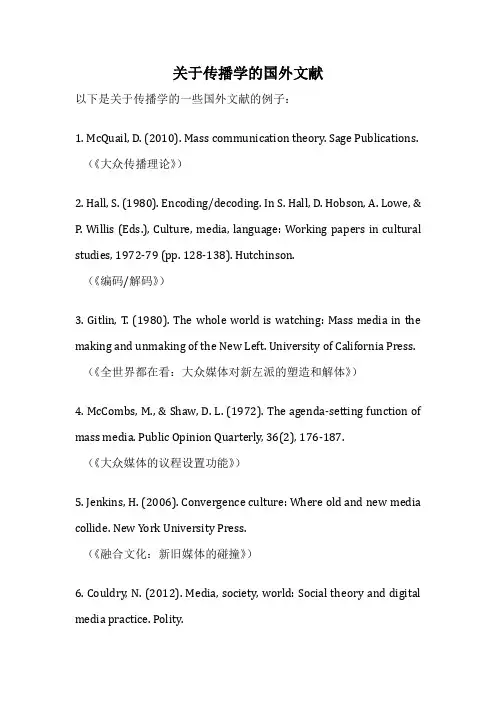
关于传播学的国外文献以下是关于传播学的一些国外文献的例子:1. McQuail, D. (2010). Mass communication theory. Sage Publications.(《大众传播理论》)2. Hall, S. (1980). Encoding/decoding. In S. Hall, D. Hobson, A. Lowe, & P. Willis (Eds.), Culture, media, language: Working papers in cultural studies, 1972-79 (pp. 128-138). Hutchinson.(《编码/解码》)3. Gitlin, T. (1980). The whole world is watching: Mass media in the making and unmaking of the New Left. University of California Press.(《全世界都在看:大众媒体对新左派的塑造和解体》)4. McCombs, M., & Shaw, D. L. (1972). The agenda-setting function of mass media. Public Opinion Quarterly, 36(2), 176-187.(《大众媒体的议程设置功能》)5. Jenkins, H. (2006). Convergence culture: Where old and new media collide. New York University Press.(《融合文化:新旧媒体的碰撞》)6. Couldry, N. (2012). Media, society, world: Social theory and digital media practice. Polity.(《媒体、社会、世界:社会理论与数字媒体实践》)7. Habermas, J. (1989). The structural transformation of the public sphere: An inquiry into a category of bourgeois society. MIT Press.(《公共领域的结构转型:对资产阶级社会范畴的探究》)8. Meyrowitz, J. (1985). No sense of place: The impact of electronic media on social behavior. Oxford University Press.(《无处感:电子媒体对社会行为的影响》)这些文献代表了传播学领域的经典和重要研究,涵盖了传播理论、媒体影响、社会媒体等方面的内容。
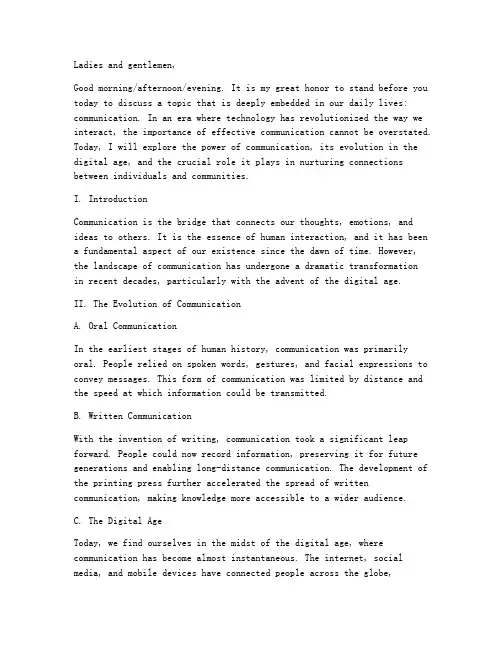
Ladies and gentlemen,Good morning/afternoon/evening. It is my great honor to stand before you today to discuss a topic that is deeply embedded in our daily lives: communication. In an era where technology has revolutionized the way we interact, the importance of effective communication cannot be overstated. Today, I will explore the power of communication, its evolution in the digital age, and the crucial role it plays in nurturing connections between individuals and communities.I. IntroductionCommunication is the bridge that connects our thoughts, emotions, and ideas to others. It is the essence of human interaction, and it has been a fundamental aspect of our existence since the dawn of time. However, the landscape of communication has undergone a dramatic transformationin recent decades, particularly with the advent of the digital age.II. The Evolution of CommunicationA. Oral CommunicationIn the earliest stages of human history, communication was primarily oral. People relied on spoken words, gestures, and facial expressions to convey messages. This form of communication was limited by distance and the speed at which information could be transmitted.B. Written CommunicationWith the invention of writing, communication took a significant leap forward. People could now record information, preserving it for future generations and enabling long-distance communication. The development of the printing press further accelerated the spread of written communication, making knowledge more accessible to a wider audience.C. The Digital AgeToday, we find ourselves in the midst of the digital age, where communication has become almost instantaneous. The internet, social media, and mobile devices have connected people across the globe,breaking down geographical barriers and fostering a sense of global community. However, this rapid evolution has also brought about challenges and new questions about the nature of communication.III. The Power of CommunicationA. Building RelationshipsEffective communication is the cornerstone of building and maintaining relationships. By expressing our thoughts, feelings, and needs, we create a sense of understanding and connection with others. This is particularly important in personal relationships, where open and honest communication fosters trust and emotional intimacy.B. Problem-SolvingCommunication plays a vital role in problem-solving. When individuals and communities engage in meaningful dialogue, they can identify issues, brainstorm solutions, and work together to find the best course of action. This collaborative approach not only resolves conflicts but also strengthens social bonds.C. Knowledge SharingThe ability to communicate allows us to share knowledge and learn from one another. Through books, lectures, and online platforms, we can access a wealth of information that can help us grow intellectually and professionally. This exchange of ideas is essential for progress and innovation.IV. Challenges of the Digital AgeA. MisinformationThe digital age has given rise to an abundance of information, but not all of it is accurate or reliable. The spread of misinformation can have harmful consequences, leading to confusion, polarization, and even violence. It is crucial for individuals to develop critical thinking skills to discern fact from fiction.B. Loss of Personal ConnectionWhile digital communication has made it easier to connect with others,it has also led to a decrease in face-to-face interactions. This loss of personal connection can affect our ability to build deep and meaningful relationships. It is important to strike a balance between online and offline communication.C. Privacy ConcernsThe digital age has also raised concerns about privacy. With the vast amount of personal data being collected and shared online, individuals must be vigilant about protecting their privacy and ensuring that their information is used responsibly.V. ConclusionIn conclusion, communication is a powerful tool that has the potential to transform our lives. As we navigate the complexities of the digital age, it is essential to recognize the importance of effective communication in building relationships, solving problems, and sharing knowledge. While the digital landscape presents challenges, we must also embrace its opportunities to create a more connected and informed world.Thank you for your attention. I welcome any questions or comments you may have regarding the power of communication in our lives.。
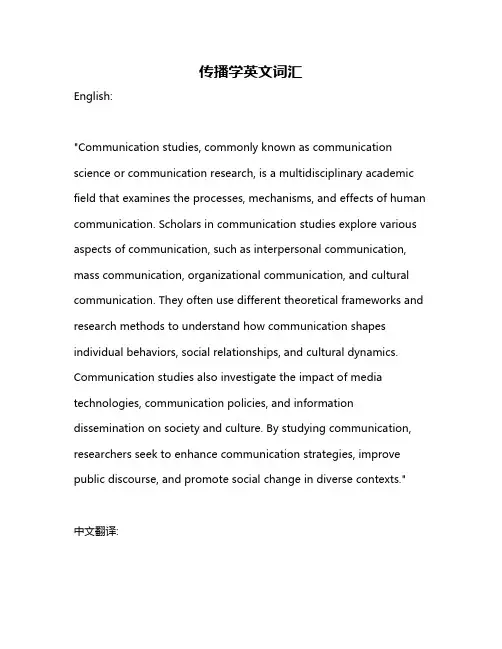
传播学英文词汇English:"Communication studies, commonly known as communication science or communication research, is a multidisciplinary academic field that examines the processes, mechanisms, and effects of human communication. Scholars in communication studies explore various aspects of communication, such as interpersonal communication, mass communication, organizational communication, and cultural communication. They often use different theoretical frameworks and research methods to understand how communication shapes individual behaviors, social relationships, and cultural dynamics. Communication studies also investigate the impact of media technologies, communication policies, and information dissemination on society and culture. By studying communication, researchers seek to enhance communication strategies, improve public discourse, and promote social change in diverse contexts."中文翻译:"传播学,通常被称为传播科学或传播研究,是一门跨学科的学术领域,研究人类交流的过程、机制和效果。
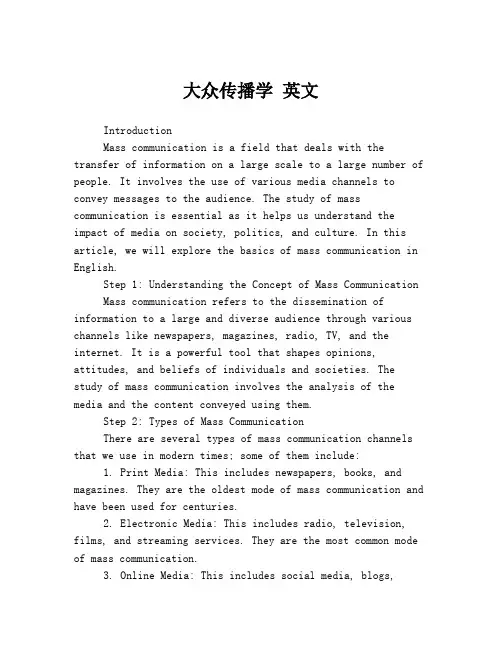
大众传播学英文IntroductionMass communication is a field that deals with the transfer of information on a large scale to a large number of people. It involves the use of various media channels to convey messages to the audience. The study of mass communication is essential as it helps us understand the impact of media on society, politics, and culture. In this article, we will explore the basics of mass communication in English.Step 1: Understanding the Concept of Mass Communication Mass communication refers to the dissemination of information to a large and diverse audience through various channels like newspapers, magazines, radio, TV, and the internet. It is a powerful tool that shapes opinions, attitudes, and beliefs of individuals and societies. The study of mass communication involves the analysis of the media and the content conveyed using them.Step 2: Types of Mass CommunicationThere are several types of mass communication channels that we use in modern times; some of them include:1. Print Media: This includes newspapers, books, and magazines. They are the oldest mode of mass communication and have been used for centuries.2. Electronic Media: This includes radio, television, films, and streaming services. They are the most common mode of mass communication.3. Online Media: This includes social media, blogs,podcasts, and websites. They have gained prominence in the21st century.Step 3: Importance of Mass CommunicationMass communication is essential as it facilitates the spread of knowledge, information, and ideas across the globe. It helps people to keep up with the latest happenings and gain awareness about current events. It also plays a crucial role in shaping public opinion on various issues. Mass communication is also a tool of entertainment and is used by people to relax and unwind.Step 4: Roles of Mass CommunicationMass communication plays several roles like:1. Informing: It provides information to the public about events, issues, and policies.2. Educating: It helps in the dissemination of knowledge and learning.3. Entertaining: It provides a source of entertainment to the masses.4. Persuading: It attempts to influence the thinking and behavior of the audience.5. Promoting: It promotes ideas, products, services, and personalities.ConclusionIn conclusion, mass communication plays a vital role in modern societies. It has a significant impact on our lives and influences our thoughts and actions. The study of mass communication is essential as it helps us understand the workings of the media and their impact on society. It also helps us to become responsible consumers of media by enabling us to critically analyze the information presented to us.。

人内传播:intra-personal communication 自我互动:self interaction象征符:symbol内省式思考:reflective thinking人际传播:personal communication集合行为:collective behavior乌合之众:crowd流言:rumor意见领袖:opinion leader两级传播:two step flow of communication 中介因素:mediating factors信息流:information flow影响流:influencing flow知沟:knowledge gap数字鸿沟:digital gap可信性:credibility专业权威性:expertness休眠效果(霍夫兰):sleeper effect诉诸理性:rational persuasion诉诸情感:emotional persuasion显著性:salience自信心假说:self-confidence hypothesis议程设置功能:the agenda-setting function:McCombs&Show What is the agenda-setting function:Media concentration on a few issues and subjects leads the public to perceive those issues as more important than other issues. That is,if a news item is covered frequently and prominently,the audience will regard the issue as more important.属性议程设置:attributes agenda-setting沉默的螺旋:the spiral of silence社会合意:social consensus意见气候:opinion climate中坚分子:the hard core培养分析:cultivation analysis故事讲解员:story-teller熔炉:melting-pot新闻框架:news frameNews frame的四种功能:Problem definition(提供问题定义);causal interpretation(阐释事件原因);moral evaluation(提供道德评价);treatment recommendation(示意解决方案)上限效果(ceiling effect)假说;信息富有者(information-rich)信息贫困者(information-poor)媒介素养(media literacy)第三人效果(the third-person effect)拉斯韦尔:Lasswell卢因:Lewin霍夫兰:Hovland拉扎斯菲尔德:Lazarsfeld施拉姆:Schramm香农:Shannon威纳:Norbert Wiener经验学派:empirical school批判学派:critical school霸权:hegemony文化帝国主义:cultural imperialism文本解析:text analysis美国源流:杜威(Dewey)库利(Cooley)提出两个概念:一是初级群体(primary group)二是镜中我(looking-glass self)帕克(Park)米德(Mead):主我(I)和客我(Me)对理解人内传播很有意义李普曼(Lippmann)拟态环境(pseudo-environment)刻板成见(stereotype)拉斯韦尔三功能说:环境监视功能(surveillance of the environment)社会联系与协调功能(correlation of the parts of society)社会遗产传承功能(transmission of social heritage)拉扎斯菲尔德三功能:社会地位赋予功能(status conferral)社会规范强制功能(enforcement of social norms)作为负面功能的“麻醉功能”(narcotizing dysfunction)电子乌托邦(teletopia)多媒体(multi-media)传播制度几种规范理论:集权主义authoritarianism受众权利:传播权(the right to communicate)知晓权(the right to know)媒介接近权(the right of access to mass media)acredited journalist n.特派记者advertisment n.广告advance n.预发消息;预写消息affair(e)n.桃色新闻;绯闻anecdote n.趣闻轶事assignment n.采写任务attribution n.消息出处,消息来源back alley news n.小道消息backgrounding n.新闻背景Bad news travels quickly.坏事传千里。
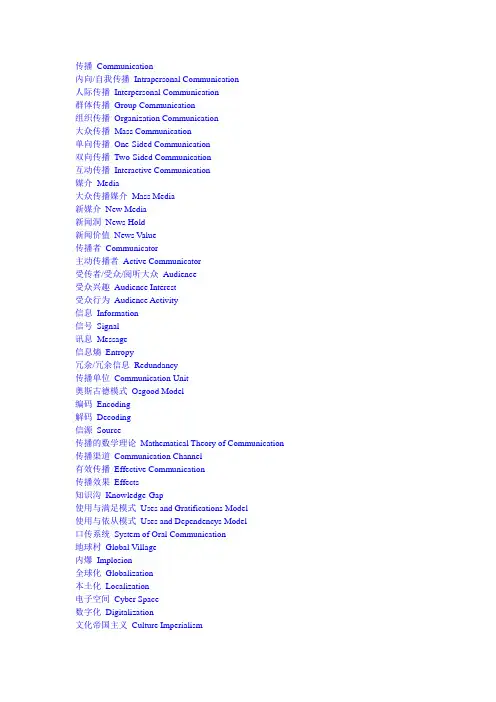
传播Communication内向/自我传播Intrapersonal Communication人际传播Interpersonal Communication群体传播Group Communication组织传播Organization Communication大众传播Mass Communication单向传播One-Sided Communication双向传播Two-Sided Communication互动传播Interactive Communication媒介Media大众传播媒介Mass Media新媒介New Media新闻洞News Hold新闻价值News Value传播者Communicator主动传播者Active Communicator受传者/受众/阅听大众Audience受众兴趣Audience Interest受众行为Audience Activity信息Information信号Signal讯息Message信息熵Entropy冗余/冗余信息Redundancy传播单位Communication Unit奥斯古德模式Osgood Model编码Encoding解码Decoding信源Source传播的数学理论Mathematical Theory of Communication 传播渠道Communication Channel有效传播Effective Communication传播效果Effects知识沟Knowledge-Gap使用与满足模式Uses and Gratifications Model使用与依从模式Uses and Dependencys Model口传系统System of Oral Communication地球村Global Village内爆Implosion全球化Globalization本土化Localization电子空间Cyber Space数字化Digitalization文化帝国主义Culture Imperialism跨文化传播Intercultural Communication 守门人Gatekeeper新闻采集者News Gatherers新闻加工者News Processors模式Model有线效果模式Limited Effects Model适度效果模式Moderate Effects Model 强大效果模式Powerful Effects Model 子弹论Bullet Theory两级传播模式Two-Step Flow Model多级传播模式Multi-Step Flow Model沉默的螺旋模式Spiral of Silence Model 劝服传播Persuasive Communication议程设置模式the Agenda-Setting Model 时滞Time Lag最合适效果跨度Optimal Effects Pan时间跨度Time Span公众舆论Public Opinion选择性接触Selective Exposure选择性注意Selective Attention选择性理解Selective Perception选择性记忆Selective Retention可信性提示Credibility Heuristic喜爱提示Liking Heuristic共识提示Consensus Heuristic。

传播学考研英文常见词汇发表评论(0)编辑词条传播 Communication内向/自我传播 Intrapersonal Communication人际传播 Interpersonal Communication群体传播 Group Communication组织传播 Organization Communication大众传播 Mass Communication单向传播 One-Sided Communication双向传播 Two-Sided Communication互动传播 Interactive Communication媒介 Media大众传播媒介 Mass Media新媒介 New Media新闻洞 News Hold新闻价值 News Value传播者 Communicator主动传播者 Active Communicator受传者/受众/阅听大众 Audience受众兴趣 Audience Interest受众行为 Audience Activity信息 Information信号 Signal讯息 Message信息熵 Entropy冗余/冗余信息 Redundancy传播单位 Communication Unit奥斯古德模式 Osgood Model编码 Encode解码 Decode信源 Source传播的数学理论 Mathematical Theory of Communication 传播渠道 Communication Channel有效传播 Effective Communication传播效果 Effects知识沟 Knowledge-Gap使用与满足模式 Uses and Gratifications Model使用与依从模式 Uses and Dependencys Model 口传系统 System of Oral Communication地球村 Global Village内爆 Implosion全球化 Globalization本土化 Localization电子空间 Cyber Space数字化 Digitalization文化帝国主义 Culture Imperialism跨文化传播 Intercultural Communication守门人 Gatekeeper新闻采集者 News Gatherers新闻加工者 News Processors模式 Model有线效果模式 Limited Effects Model适度效果模式 Moderate Effects Model强大效果模式 Powerful Effects Model子弹论 Bullet Theory两级传播模式 Two-Step Flow Model多级传播模式 Multi-Step Flow Model沉默的螺旋模式 Spiral of Silence Model劝服传播 Persuasive Communication议程设置模式 the Agenda-Setting Model时滞 Time Lag最合适效果跨度 Optimal Effects Pan时间跨度 Time Span公众舆论 Public Opinion选择性接触 Selective Exposure选择性注意 Selective Attention选择性理解 Selective Perception选择性记忆 Selective Retention可信性提示 Credibility Heuristic喜爱提示 Liking Heuristic共识提示 Consensus Heuristic市场驱动新闻学 the Market-Driven Journalism 意识形态 Ideology霸权 Hegemony权力话语 Power Discourse视觉文本 Visual Text文本 Text超级文本 Hypertext结构主义 Constructionism解构主义 Deconstructionism文化工业 Culture Industry大众文化 Mass Culture文化研究 Cultural Studies批判学派/批判理论 Critical Theory法兰克福学派 Frankfurt School女权主义/女性主义 Feminism符号学 Semiotics/Semiology符号 Sign能指与所指 Signified/Signifier非语言符号 Nonverbal Sign非语言传播 Nonverbal Communication意指 Signification话语理论 Theories of Discourse文化期待 Culture Expectations文化批判 Culture Criticizing范式 Paradigm叙事范式 Narrative Paradigm强语境 High Context弱语境 Low Context功能理论 Functionalism话语分析 Discourse Analysis传播的商品形式 the Commodity Forms of Communication 受众商品 Audience Commodity商品化 Commodification空间化 Spatialization结构化 Structuration媒介集中化 Media Conglomeration传媒产业 Media Industry注意力经济 Attention Economy媒介竞争 Media Competition受众分割 Audience Segmentation媒介资本 Media Capital传播政治经济学 Political Economy of Communication 传播研究 Communication Research抽样 Sampling调查研究方法 Survey Research内容分析法 Content Analysis实验分析法 Experimental Research定性研究法 Qualitative Research Methods个案研究法 Case Study效度与信度 Validity/Reliability变量 Variables实地观察法 Field Observation虚拟社群 Virtual Community扩散研究 Diffusion Research媒介事件 Media Events民族志 Ethnography传播生态 Ecology of Communication真实/虚构 Reality/Fiction拟态环境 Pseudo-Environment刻板成见 Stereotyping晕轮效应 Halo Effects二元价值评判 Two-Valued Evaluation公共关系 Public Relation阐释理论 Interpretive Theory。
传播学传媒经典书籍传播学和传媒是当今社会中非常重要的领域,涉及到了人们的信息传递、意识形态、文化传承等方面。
因此,对于这个领域的学习和研究,经典书籍是必不可少的。
下面就是一些传播学和传媒领域的经典书籍。
1.《传播学原理》(Communication Principles for a Lifetime):这是一本非常经典的传播学教材,由美国传播学家斯蒂文·A·麦克卢汉(Steven A. McQuail)和朱利安·D·尼卡尔(Julian D. Niccolai)合著,内容涵盖了传播学的基本原理、理论和实践。
2.《传播学概论》(Introduction to Communication Studies):这是一本由南非传播学家约翰·弗莱明(John Fiske)所著的传播学入门教材,内容涵盖了传播学的基本概念、理论和实践。
3.《传播学理论与研究方法》(Communication Theory and Research Methods):这是一本由美国传播学家詹姆斯·W·纽曼(James W. Newman)和威廉·R·罗森贝格(William R. Rosenberger)合著的传播学理论和研究方法教材,内容涵盖了传播学的理论和研究方法。
4.《媒介与现代性》(Media and Modernity):这是一本由英国社会学家约翰·B·汤普森(John B. Thompson)所著的媒介与现代性研究著作,内容涵盖了媒介与现代性的关系、媒介的社会功能和影响等方面。
5.《媒介文化批评》(Cultural Criticism and Society):这是一本由美国文化批评家道格拉斯·库尔特(Douglas Kellner)所著的媒介文化批评著作,内容涵盖了媒介文化的批评和分析。
6.《媒介与社会》(Media and Society):这是一本由美国传播学家詹姆斯·W·纽曼(James W. Newman)所著的媒介与社会研究著作,内容涵盖了媒介与社会的关系、媒介的社会功能和影响等方面。
传播学专业英语词汇表第一部分:基本传播学理论词汇传播Communication内向/自我传播Intrapersonal Communication人际传播Interpersonal Communication群体传播Group Communication组织传播Organization Communication大众传播Mass Communication单向传播One-Sided Communication双向传播Two-Sided Communication互动传播Interactive Communication媒介Media大众传播媒介Mass Media新媒介New Media新闻洞News Hold新闻价值News Value传播者Communicator主动传播者Active Communicator受传者/受众/阅听大众Audience受众兴坤Audience Interest受众行为Audience Activity信息Information信号Signal讯息Message信息熵Entropy冗余/冗余信息Redundancy传播单位Communication Unit奥斯古德模式Osgood Model编码Encoding解码Decoding信源Source传播的数学理论Mathematical Theory of Communication 传播渠道Communication Channel有效传播Effective Communication传播效果Effects知识沟Knowledge-Gap使用与满足模式Uses and Gratifications Model使用与依从模式Uses and Dependencys Model口传系统System of Oral Communication地球村Global Village内爆Implosion全球化Globalization本土化Localization电子空间Cyber Space数字化Digitalization文化帝国主义Culture Imperialism跨文化传播Intercultural Communication守门人Gatekeeper新闻采集者News Gatherers新闻加工者News Processors模式Model有线效果模式Limited Effects Model适度效果模式Moderate Effects Model 强大效果模式Powerful Effects Model子弹论Bullet Theory两级传播模式Two-Step Flow Model多级传播模式Multi-Step Flow Model沉默的螺旋模式Spiral of Silence Model 劝服传播Persuasive Communication议程设置模式the Agenda-Setting Model 时滞Time Lag最合适效果跨度Optimal Effects Pan时间跨度Time Span公众舆论Public Opinion选择性接触Selective Exposure选择性注意Selective Attention选择性理解Selective Perception选择性记忆Selective Retention可信性提示Credibility Heuristic喜爱提示Liking Heuristic共识提示Consensus Heuristic市场驱动新闻学the Market-Driven Journalism 意识形态Ideology霸权Hegemony权力话语Power Discourse视觉文本Visual Text文本Text超级文本Hypertext结构主义Constructionism解构主义Deconstructionism文化工业Culture Industry大众文化Mass Culture文化研究Cultural Studies批判学派/批判理论Critical Theory法兰克福学派Frankfurt School女权主义/女性主义Feminism符号学Semiotics/Semiology符号Sign能指与所指Signified/Signifier非语言符号Nonverbal Sign非语言传播Nonverbal Communication意指Signification话语理论Theories of Discourse文化期待Culture Expectations文化批判Culture Criticizing范式Paradigm叙事范式Narrative Paradigm强语境High Context弱语境Low Context功能理论Functionalism话语分析Discourse Analysis传播的商品形式the Commodity Forms of Communication 受众商品Audience Commodity商品化Commodification空间化Spatialization结构化Structuration媒介集中化Media Conglomeration传媒产业Media Industry注意力经济Attention Economy媒介竞争Media Competition受众分割Audience Segmentation媒介资本Media Capital传播政治经济学Political Economy of Communication传播研究Communication Research抽样Sampling调查研究方法Survey Research内容分析法Content Analysis实验分析法Experimental Research定性研究法Qualitative Research Methods个案研究法Case Study效度与信度Validity/Reliability变量Variables实地观察法Field Observation虚拟社群Virtual Community扩散研究Diffusion Research媒介事件Media Events民族志Ethnography传播生态Ecology of Communication 真实/虚构Reality/Fiction拟态环境Pseudo-Environment刻板成见Stereotyping晕轮效应Halo Effects二元价值评判Two-Valued Evaluation 公共关系Public Relation阐释理论Interpretive Theory第二部分:新闻采编相关词汇daily 日报morning edition 晨报evening edition 晚报quality paper 高级报纸popular paper 大众报纸evening paper 晚报government organ 官报part organ 党报trade paper 商界报纸vernacular paper 本国文报纸political news 政治报纸Newspaper Week 新闻周刊the front page 头版第一版bulldog edition 晨版article 记事headline 标题banner headline 头号大标题byline 标题下署名之行dateline 日期、发稿地之行big news 头条新闻hot news 最新新闻exclusive news 独家新闻scoop 特讯feature 特写花絮criticism 评论editorial 社论review comment 时评book review 书评topicality 时事问题city news 社会新闻column 栏letters 读者投书栏general news column 一槃消息栏cartoon comics 漫画weather forecast 天气预报serial story 新闻小说obituary notice 讣闻public notice 公告advertisement 广告calssified ad 分类广告flash-news 大新闻extra 号外the sports page 运动栏literary criticism 文艺评论Sunday features 周日特刊newsbeat 记者采访地区news blackout 新闻管制press ban 禁止刊行yellow sheet 低俗新闻tabloid 图片版新闻"Braille" edition 点字版newspaper office 报社publisher 发行人proprieter 社长bureau chief copy chief 总编辑editor-in-chief 总主笔editor 编辑主笔newsman newspaperman journalist 新闻记者cub reporter 初任记者reporter 采访记者war correspondent campaign badge 随军记者columnist 专栏记者star reporter 一流通讯员correspondent 通讯员special correspondent 特派员contributor 投稿家news source 新闻来源informed sources 消息来源newspaper campaign 新闻战free-lancer writer 自由招待会press box 记者席news conference press conference 记者招待会International Press Association 国际新闻协会distribution 发行circulation 发行份数newsstand kiosk 报摊newspaper agency 报纸代售处newsboy 报童subscription (rate) 报费newsprint 新闻用纸Fleet Street 舰队街accredited journalist n. 特派记者advertisement n.广告.advance n.预发消息;预写消息affair n.桃色新闻;绯闻anecdote n.趣闻轶事assignment n.采写任务attribution n. 消息出处,消息来源back alley news 小道消息backgrounding 新闻背景Bad news travels quickly. 坏事传千里。
传播学经典理论英文版[中文批注] 目录 一、 Opinion Leaders 意见领袖 __________________________________________ 2 ____ 二、 5W Box 5w 理论 __________________________________________________ _ ______
三、 The Bias of Communication 传媒偏向论 _________________________________ 2 四、 The Spiral of Silenee 沉默的螺旋 _____________________________________ 3 五、 Gatekeeper把关人理论 _____________________________________________ 4 ____ 六、 Selective exposure hypothesis 选择性接触假说 ____________________________ 4 七、 Knowledge Gap Theory 知识沟假说 ____________________________________ 5 八、 Agenda Setting Theory 议程设置理论 ___________________________________ 5 九、 Magic bullet theory 魔弹论 ____________________________________________ 5 ____ 十、Information (Innovation ) Diffusion Theory 信息(创新)扩散论 ____________________ 6 十^一、 Uses a nd gratificati ons theory (UGT)使用与满足理论 ______________________ 7 十二、Cultivation theory 教养理论 ___________________________________________ 8 十三、Limited-Effects Theory 有限效果论 ______________________________________ 8 十四、 Marshall Mcluhan Media Theory麦克卢汉的媒介理论 ________________________ 9 2/ 11 一、Opinion Leaders 意见领袖 Active in information networks, have many information channels ,so they can often provi de in formati on and advice for others and can in flue nee others.
意见领袖是指在人际传播网络中经常为他人提供信息,同时对他人施加影响的“活跃分子”,他们在大众传播效果的 形成过程中起着重要的中介或过滤的作用,由他们将信息扩散给受众,形成信息传递的两级传播。 二、 5W Box 5w 理论 1. Who com muni cates to whom?(sources and receivers) 2. Why com muni cate?(fu ncti on and purposes) 3. How does com muni cati on take place?(cha nn els,la nguages,codes) 4. What about?(c on tent,references,types of information) 5. What are the outcomes of com muni cati on (intend or uninten ded ),for in formati on, understandings, action the Riseof Mass Mdia 美国学者H •拉斯维尔于1948年在《传播在社会中的结构与功能》一篇论文中,首次提出了构成传播过程的五种基 本要素,并按照一定结构顺序将它们排列,形成了后来人们称之“五 W模式”或“拉斯维尔程式”的过程模式。这五个 W分别是英语中五个疑问代词的第一个字母,即: Who (谁)Says What (说了什么)In Which Cha nnel (通过 什么渠道) To Whom (向谁说) With What Effect (有什么效果)。 三、 The Bias of Com muni cati on 传媒偏向论 Inn is ' cen tral focus is the social history of com muni cati on media; he believed that the rel ative stability of cultures depends on the balanee and proportion of their media. To begi n our inquiry into this area, he suggests we ask three basic questions: How do specific c ommuni cati on tech no logies operate? What assumpti ons do they take from an d con trib ute to society? What forms of power do they encourage? For Inn is, a key to social cha nge isfo und in the developme nt of com muni cati on media. He claims that each medium embodies a bias in terms of the organization and control of information. Any empire or society isgenerally concerned with duration over time and e xtension in space. Time-biased media, such as st one and clay, are durable and heavy. Si nee they are difficu It to move, they do not encourage territorial expansion; however, since they have a long life, they do encourage the extension of empire over time. Innis associated these media with the customary, thesacred, and the moral. Time-biased media facilitate the develop ment of social hierarchies, asarchetypally exemplified by ancient Egypt. For Innis, speec h is a time-biased medium. Space-biased media are light and portable; they can be transported over large distances .They are associated with secular a nd territorial societies; they facilitate the expa nsion of empire over space. Paper is such a medium; it is readily transported, but has a relatively short lifespan.
伊尼斯发现,媒介可以分为两大类,两者有一个基本的区别:有利于空间上延伸的媒介和有利于时间上延续的媒介。 比如,石版文字和泥版文字耐久,它们承载的文字具有永恒的性质,容易传承。但是,它们不容易运输,不容易生 产,不容易使用,因而不利于空间上的传播。相反,莎草纸和纸张轻巧,容易运输,使用方便,能够远距离传播迅 息,然而它们传播的迅息却限于当下,就比较短暂。 他认为,传播和传播媒介都有偏向,大体上分为:口头传播的偏向与书面传播的偏向,时间的偏向与空间的偏向。 下面这段话,痛快淋漓地阐明伊尼斯“传播偏向论”的意旨、要害,说明媒介的性质和偏向,并且说明媒介为何有这 些偏向。他说: “倚重时间的媒介,其性质耐久,羊皮纸、黏土和石头即为其例……倚重空间的媒介,耐久性比较逊色,质地比 较轻。后者适合广袤地区的治理和贸易……倚重空间的材料,有利于集中化……我们考虑大规模的政治组织,比如帝 国时,必须立足在空间和时间两个方面。我们要克服媒介的偏向,既不过分倚重时间,也不过分倚重空间。” 强调媒介偏向、时间偏向和空间偏向的关系,并指出媒介与国家僚体制和宗教的关系。他说: “一个成功的帝国必须充分认识到空间问题,空间问题既是军事问题,也是政治问题;它还要认识到时间问题,时 间问题既是朝代问题和人生寿限问题,也是宗教问题。又说:“国家的官僚体制倚重空间,忽略时间。相反,宗教 却倚重时间,忽略空间。” 四、The Spiral of Silenee 沉默的螺旋
The spiral of sile nee is a political scie nee a nd mass com muni cati on theory propo un ded b y the German political scientist Elisabeth Noelle-Neumann. Spiral of silenee theory descr ibes the process by which one opinion becomes dominant as those who perceive their o pinion to be in the minority do not speak up because society threatens individuals with f ear of isolation. The assessment of one's social environment may not always correlate wi th reality. For a c on troversial issue,people will watch the "climate of opinion" before they make co mments . judging their opinion whether the "majority opinion", when people feel that th eir views are "majority" or in the "adva ntage" , it will tend to boldly express this op inion; when found his views are "a few" or in a "disadvantage" they often remain "silent." The more people rema in sile nt, the more feel that their views are not well accepted, thus a re sult, the more they tend to remain silent. Repeated several times, they form representing "dominant" status views and more powe rful, while holding "inferior" opinions of people sound more and more weak, such a cycle ,forming a "one more loudly, and the other more and more silent spiral down the proce ss." 沉默的螺旋理论提供了一种考虑问题的视角:团队意见的形成不一定是团队成员“理性讨论”的结果,而可能是对团 队中“强势”意见的趋同后的结果。需要注意的是:“强势”意见所强调的东西,不一定就是正确的。当团队中的少数 意见与“多数”意见不同的时候,少数有可能屈于“优势意见”的压力,表面上采取认同,但实际上内心仍然坚持自己 的观点,这就可能出现某些团队成员公开“表达的意见”与团队成员“自己的意见”不一致。要跳出沉默的螺旋,唯一 的出路就是尊重少数派,聆听反对者的声音。